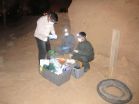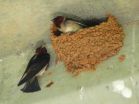(Press-News.org) An estimated three-quarters of camels recently surveyed in Saudi Arabia have evidence of infection with the Middle East Respiratory Syndrome coronavirus (MERS-CoV), the virus responsible for human cases of MERS. Results of the new study establish for the first time that direct camel-to-human transmission is possible and provide a pathway to control the spread of the disease.
Results in the journal mBio are reported by scientists at the Center for Infection and Immunity at Columbia University's Mailman School of Public Health; Mammals Research Chair, King Saud University, Riyadh, Saudi Arabia; the National Institute of Allergy and Infectious Diseases at the National Institutes of Health; and EcoHealth Alliance.
To date, at least 182 people have been infected with the virus that causes MERS and 79 have died since the first documented case in Saudi Arabia in September 2012. Since then, most cases have been in Saudi Arabia, with lower numbers in Jordan, Qatar, Tunisia, and the United Arab Emirates. France, Germany, Italy, and the United Kingdom have also reported cases related to travel to the Middle East. So far the source of the disease has remained a mystery.
An analysis of blood samples collected from 203 camels across Saudi Arabia in 2013 found 150, or 74%, had antibodies to the MERS coronavirus, indicating past infection. Nasal swabs and rectal specimens revealed that genetic sequences of MERS-CoV from active infection in camels matched those found in humans. The rate of camels with active MERS-CoV infection varied widely by region, ranging from 66% of camels in Taif in the west to none in Gizan in the southwest. Young camels were more than twice as likely as adults to be infected. No evidence of MERS was seen in a similar survey of sheep and goats.
"This study is the first to show that the MERS virus seen in humans is widespread in camels throughout Saudi Arabia," says first author Abdulaziz N. Alagaili, PhD, the director of the Mammals Research Chair at King Saud University. "This information is crucial for efforts to contain the spread of the disease. To this end, I want to thank His Excellency Minister of Higher Education Dr. Khalid Al Anqari; His Highness Prince Bandar bin Saud Al Saud, president of the Saudi Wildlife Authority, and Professor Badran Alomar, president of King Saud University, for their continued support of this important project."
Airborne transmission of the virus between camels is most likely based on a number of clues, including that the virus was more evident in nasal swabs as opposed to rectal specimens. But how humans get the disease has not yet been determined.
"What we know now is that camels carry the same MERS virus that infects humans, which indicates that they have the potential to transmit the virus directly to humans," says study co-author Thomas Briese, PhD, associate director of the Center for Infection and Immunity and associate professor of epidemiology at the Mailman School.
"A study we published last year found that the virus was carried in a bat found near the first known human case of MERS," adds Dr. Briese. "The roles of bats and camels in human infection remains an area of active research for our group and others."
MERS-CoV in Camels Since 1992 or Earlier
MERS-CoV has been carried by camels in Saudi Arabia for more than 20 years, and likely longer. The researchers looked at blood serum samples from camels, finding evidence of the virus dating back to 1992, the earliest sample. MERS is not fatal in camels and there are so far no outward signs of the disease, although researchers say the animal's characteristic drool could be related.
Human cases of MERS-CoV may have a longer history than previously thought. Before the index case in 2012, they may have been labeled as a more generic "unexplained respiratory disease." Unfortunately there are no available human samples to test the hypothesis.
New Mobile Lab, Saudi Collaboration
Alongside its insights into MERS-CoV, the study also cemented collaborations and validated systems that will carry forward into future studies of MERS-CoV and other infectious disease threats.
"The study is the first collaboration between the Center for Infection and Immunity and King Saud University, as well as the first to use the Center's new mobile field laboratory, that is designed to enable surveillance, discovery and service missions in support of international organizations like the World Health Organization," says senior author W. Ian Lipkin, MD, director of the Center for Infection and Immunity and the John Snow Professor of Epidemiology at the Mailman School. "We look forward to continued work toward to ultimate goal of eliminating the threat of MERS and other infectious agents to human health."
INFORMATION:
Additional co-authors include Nischay Mishra, Vishal Kapoor, Stephen C. Sameroff, and Amit Kapoor of the Center for Infection and Immunity; Emmie de Wit, Vincent J. Munster, and Lisa E. Hensley of the National Institute of Allergy and Infectious Diseases, National Institutes of Health; Jonathan H. Epstein, William B. Karesh, and Peter Daszak of EcoHealth Alliance; and Iyad S. Zalmout and Osama B. Mohammed of King Saud University.
The KSU Mammals Research Chair is supported by the Deanship of Scientific Research, King Saud University. Work in the Center for Infection and Immunity and EcoHealth Alliance is supported by awards from the National Institutes of Health (AI057158) and the United States Agency for International Development's Emerging Pandemic Threat Program, PREDICT project, under terms of Cooperative Agreement Number GHN-A-OO-09-00010-00. Work in the Rocky Mountain Laboratories (De Wit, Munster) and Integrated Research Facility (Hensley) was supported by the Intramural Research Program of the National Institute of Allergy and Infectious Diseases, National Institutes of Health.
About Columbia University's Mailman School of Public Health
Founded in 1922, Columbia University's Mailman School of Public Health pursues an agenda of research, education, and service to address the critical and complex public health issues affecting New Yorkers, the nation and the world. The Mailman School is the third largest recipient of NIH grants among schools of public health. Its over 450 multi-disciplinary faculty members work in more than 100 countries around the world, addressing such issues as preventing infectious and chronic diseases, environmental health, maternal and child health, health policy, climate change & health, and public health preparedness. It is a leader in public health education with over 1,300 graduate students from more than 40 nations pursuing a variety of master's and doctoral degree programs. The Mailman School is also home to numerous world-renowned research centers including ICAP (formerly the International Center for AIDS Care and Treatment Programs) and the Center for Infection and Immunity. For more information, please visit http://www.mailman.columbia.edu.
Saudi Arabian camels carry MERS virus
Countrywide survey finds virus in humans and camels match, establishes that direct camel-to-human transmission is possible and likely
2014-02-25
ELSE PRESS RELEASES FROM THIS DATE:
Novel optical fibers transmit high-quality images
2014-02-25
MILWAUKEE – After having recently discovered a new way to propagate multiple beams of light through a single strand of optical fiber, engineers at the University of Wisconsin-Milwaukee (UWM) now have found that their novel fiber architecture can transmit images with a quality that is comparable or better than the current commercial endoscopy imaging fibers.
Because of this, the work has potential not only in next-generation high-speed communication, but also biomedical imaging.
The work is published today in the journal Nature Communications.
In conventional optical ...
Mood and food: The better your mood, the better you eat
2014-02-25
Previous research has found that emotions affect eating, and that negative moods and positive moods may actually lead to preferences for different kinds of foods. For example, if given the choice between grapes or chocolate candies, someone in a good mood may choose the former while someone in a bad mood may choose the latter. The research reported in this article looks at the "why:" Why, when someone is in a bad mood, will they choose to eat junk food and why, when someone is in a good mood, will they make healthier food choices?
To get at the "why," we married the ...
Use of acetaminophen during pregnancy linked to ADHD in children, UCLA researchers say
2014-02-25
Acetaminophen, found in over-the-counter products such as Excedrin and Tylenol, provides many people with relief from headaches and sore muscles. When used appropriately, it is considered mostly harmless. Over recent decades, the drug, which has been marketed since the 1950s, has become the medication most commonly used by pregnant women for fevers and pain.
Now, a long-term study by UCLA, in collaboration with the University of Aarhus in Denmark, has raised concerns about the use of acetaminophen during pregnancy.
In a report in the current online edition of ...
Building a better mouse model to understand pancreatic cancer
2014-02-25
(SALT LAKE CITY)—Cancer of the pancreas is usually not detected until it's too late to cure. But precursor lesions that form in the pancreas and its ducts can signal the disease before it strikes, and when caught early enough, they can be prevented from progressing to become cancer.
In a new study, researchers led by a molecular biologist at the University of California, San Francisco (UCSF), report two breakthroughs in understanding those lesions and their role in pancreatic cancer: the development of the first mouse model that simulates a precursor lesion called intraductal ...
Water is detected in a planet outside our solar system
2014-02-25
Water has been detected in the atmosphere of a planet outside our solar system with a new technique that could help researchers to learn how many planets with water, like Earth, exist throughout the universe. The team of scientists that made the discovery includes astronomers at Penn State University and other institutions. The astronomers detected the water in the atmosphere of a planet as massive as Jupiter that is orbiting the nearby star tau Boötis. The discovery is described in a scientific paper published in the 24 February 2014 online version of The Astrophysical ...
New blood test could detect heart attacks more quickly
2014-02-25
MAYWOOD, Ill. – A new blood test can detect heart attacks hours faster than the current gold-standard blood test, according to a study led by Loyola University Chicago Stritch School of Medicine researchers.
The new test measures a protein that is released to the bloodstream by dying heart muscle. The protein is called cardiac myosin binding protein-C (cMyBP-C). The study found that cMyBP-C is released to the blood within just 15 minutes of cardiac damage, and rises to significant levels in three hours.
"This is a potential ultra-early biomarker that could confirm whether ...
Vascular disease affecting women 'poorly understood' by many health care providers
2014-02-25
MAYWOOD, IL – A vascular disease called fibromuscular dysplasia, which can cause high blood pressure, kidney failure, stroke and other symptoms -- mostly in women -- is "poorly understood by many healthcare providers," according to a Scientific Statement from the American Heart Association.
Neurologist Jose Biller, MD, of Loyola University Medical Center, is a co-author of the statement, published online ahead of print in the American Heart Association journal Circulation. First author is Jeffrey W. Olin, DO of Mount Sinai School of Medicine.
Biller said FMD "is a ...
Using stolen computer processing cycles to mine Bitcoin
2014-02-25
A team of computer scientists at the University of California, San Diego, has taken an unprecedented, in-depth look at how malware operators use the computers they infect to mine Bitcoin, a virtual currency whose value is highly volatile.
Researchers examined more than 2,000 pieces of malware used by Bitcoin mining operations in 2012 and 2013. They were able to estimate how much money operators made off their operations and which countries were most affected. The computer scientists report that the revenue of 10 of the mining operations they studied reached at least 4,500 ...
Strawberries lower cholesterol
2014-02-25
A team of volunteers ate half a kilo of strawberries a day for a month to see whether it altered their blood parameters in any way. At the end of this unusual treatment, their levels of bad cholesterol and triglycerides reduced significantly, according to the analyses conducted by Italian and Spanish scientists.
Several studies had already demonstrated the antioxidant capacity of strawberries, but now researchers from the Università Politecnica delle Marche (UNIVPM, Italy), together with colleagues from the Universities of Salamanca, Granada and Seville (Spain), conducted ...
The importance of (experimental) design
2014-02-25
There are clear advantages to living in cities: safety, ready availability of infrastructure, plenty of company etc. Nevertheless, a large number of people eschew them for the benefits of country life, such as clean air and lots of space. Many species of animals, and particularly birds, face the same choice between living in large groups or remaining in smaller ones, thereby avoiding disadvantages of larger colonies such as the increased risk of disease and increased aggression from neighbours. What causes different individuals of a particular species to take the decisions ...
LAST 30 PRESS RELEASES:
New expert guidance urges caution before surgery for patients with treatment-resistant constipation
Solar hydrogen can now be produced efficiently without the scarce metal platinum
Sleeping in on weekends may help boost teens’ mental health
Study: Teens use cellphones for an hour a day at school
After more than two years of war, Palestinian children are hungry, denied education and “like the living dead”
The untold story of life with Prader-Willi syndrome - according to the siblings who live it
How the parasite that ‘gave up sex’ found more hosts – and why its victory won’t last
When is it time to jump? The boiling frog problem of AI use in physics education
Twitter data reveals partisan divide in understanding why pollen season's getting worse
AI is quick but risky for updating old software
Revolutionizing biosecurity: new multi-omics framework to transform invasive species management
From ancient herb to modern medicine: new review unveils the multi-targeted healing potential of Borago officinalis
Building a global scientific community: Biological Diversity Journal announces dual recruitment of Editorial Board and Youth Editorial Board members
Microbes that break down antibiotics help protect ecosystems under drug pollution
Smart biochar that remembers pollutants offers a new way to clean water and recycle biomass
Rice genes matter more than domestication in shaping plant microbiomes
Ticking time bomb: Some farmers report as many as 70 tick encounters over a 6-month period
Turning garden and crop waste into plastics
Scientists discover ‘platypus galaxies’ in the early universe
Seeing thyroid cancer in a new light: when AI meets label-free imaging in the operating room
Neutrophil-to-lymphocyte ratio may aid risk stratification in depressive disorder
2026 Seismological Society of America Annual Meeting
AI-powered ECG analysis offers promising path for early detection of chronic obstructive pulmonary disease, says Mount Sinai researchers
GIMM uncovers flaws in lab-grown heart cells and paves the way for improved treatments
Cracking the evolutionary code of sleep
Medications could help the aging brain cope with surgery, memory impairment
Back pain linked to worse sleep years later in men over 65, according to study
CDC urges ‘shared decision-making’ on some childhood vaccines; many unclear about what that means
New research finds that an ‘equal treatment’ approach to economic opportunity advertising can backfire
Researchers create shape-shifting, self-navigating microparticles
[Press-News.org] Saudi Arabian camels carry MERS virusCountrywide survey finds virus in humans and camels match, establishes that direct camel-to-human transmission is possible and likely








